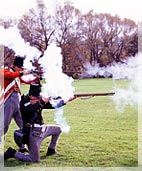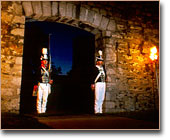Old Fort Erie
Old Fort Erie has an important place in Canadian and American history. At the end of the Seven Years War (or French and Indian War) in 1783, all of New France was ceded to Great Britain.
- Advertisement -
British established control by occupying the French forts and constucting a line of communications along the Niagara River and Upper Great Lakes.
Old Fort Erie was the first British fort to be constructed as part of this network. The original fort, built in 1764, was located on the river's edge below the present fort.

For the next 50 years, old Fort Erie served as a supply depot and a port for ships transporting merchandise, troops and passengers to the Upper Great Lakes.
The fort first saw action as a supply base for British troops, Loyalist Rangers and Iroquois Warriors during the American Revolution.
Constant winter storms caused considerable damage to the little fort at the water's edge. In 1803, planning began for a new, stronger fort to be built on the Heights behind the old fort. The War of 1812 The new fort was unfinished when the United States declared war on June 18, 1812. The garrison of Fort Erie fought at the Battle of Frenchman's Creek against American attacks in November 1812.

In 1813, the fort was held for a period by US forces after being partially dismantled by the small garrison on British troopa and Canadian militia as they withdrew from the fort.
British reoccupation followed the American withdrawal from the area in December 1813 and attempts to rebuild the fort were begun.
On July 3, 1814 another American force landed nearby and captured Fort Erie again. The US Army used the fort as a supply base and expanded its size.
At the end of July, after the Battles of Chippawa and Lundy's Lane, the American army withdrew to Fort Erie.
In the early hours of August 15, 1814 the British launched a four pronged attack against the fortifications. A well-prepared American defence and an explosion in the North East Bastion destroyed the British chance for success with the loss of over 1,000 men.
A full scale siege set in and it was broken on September 17 when American troops emerged from the fort to capture and wreck the British siege batteries.

Shortly after the American's success, the British lifted the siege lines and retired to positions to the north at Chippawa.
After unsuccessful attacks at Cook's Mills, west of Chippawa, news reached the American forces that the eastern seaboard of the US was under attack.
On the 5th of November 1814, with winter approaching, the Americans destroyed the fort and withdrew to Buffalo, leaving Fort Erie the bloodiest battlefield in the history of Canada.
The Treaty of Ghent was signed December 24, 1814, ending the War of 1812-1814.

After 1815 - Expecting further attacks, the British continued to occupy the ruined fort until 1823.
The Fort Erie area became significant as the major terminus in Canada for slaves using the Underground Railroad in the middle of the 1800's. With the arrival of trains a town began to grow north of the fort.
In 1866, a Brigade of Fenians (Irish Republicans) used the ruins of the Old Fort Erie as a base for their raid into Ontario. These raids hastened the move toward Confederation and Canada became a nation in 1867.
The fort was restored to the 1812-1814 period and officially reopened July 1, 1939. The fort and surrounding battlefield are owned and operated by the Niagara Parks Commission.
Location: 350 Lakeshore Road, Fort Erie, Ontario (30 Km south of Niagara Falls)
Cost: Adult $12.25
Kids 6 - 12 $7.95
Kids 5 & under Free
(Canadian $ before taxes)
Schedule: Subject to change:
May 2 to Labour Day, Daily 10 am to 5 pm,
Labour Day to Thanksgiving Day, Daily 10 am to 4 pm
Return to the History of Niagara page
New! Comments
Have your say about what you just read! Leave me a comment in the box below.